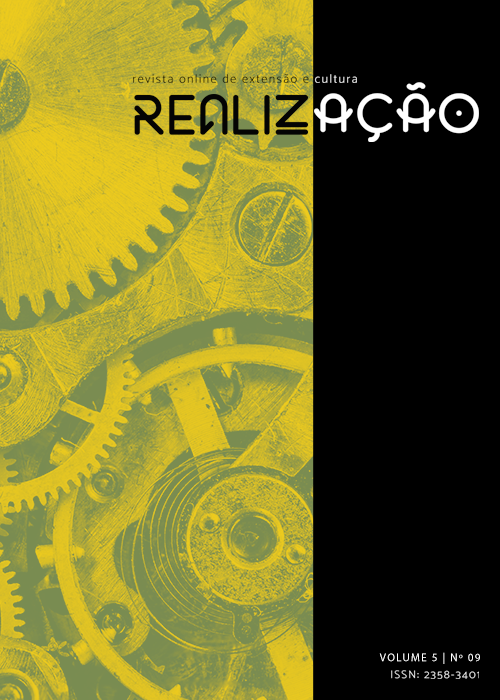Quintais medicinais e produtivos como alternativa para restauração do Cerrado
DOI:
https://doi.org/10.30612/re-ufgd.v5i9.8579Palavras-chave:
Equilíbrio ecológico , Flores , NutrientesResumo
O modelo de agricultura familiar se destaca por apresentar facilidade e adaptação aos princípios da agricultura orgânica e agroecológica, sobretudo pela indução do equilíbrio ecológico, reciclagem de nutrientes, insumos caseiros, conservação do solo e controle de pragas e doenças de maneira ecológica. Diante disso, um grupo de agricultores do município de Sidrolândia-MS, após serem assentados em 2014, decidiram iniciar um trabalho de manutenção dos solos nos quintais de suas propriedades, com o objetivo de recuperar o solos degradados por ação antrópica, e consequentemente o banco de sementes do local, transformando os espaços, tornando-os quintais produtivos e medicinais, com plantas nativas e exóticas, iniciando em pequenos espaços, com a ideia de ir ocupando o panorama de toda a propriedade com o passar dos anos. Dentre os resultados destacou-se que após seis meses de intervenção os quintais das propriedades apresentavam flores de diferentes espécies, seguidas de árvores frutíferas. O próximo passo será implantar o sistema numa área maior e em outras propriedades, possibilitando que outros espaços iniciem o processo de restauração e geração de renda.Downloads
Referências
BELTRÃO, N.E.M. Agricultura orgânica e seu potencial como estratégia de produção. In: Simpósio Nacional Sobre as Culturas ao Inhame a do Taro. Anais. João Pessoa, 2002, p. 71-94.
BRITO, M.A.; COELHO, M.F.B. Os quintais agroflorestais em regiões tropicais unidades autossustentáveis. Revista Agricultura Tropical. v. 1, n. 4, p. 7-38. 2000.
EISENHAUR, N. Aboveground-belowground interactions as a source of complementarity effects in biodiversity experiments. Plant and Soil, Netherlands, v. 351, n.1-2, p.1-22, fev. 2012.
FERREIRA, A.B.H. Dicionário Aurélio. 5 eds. São Paulo: Editora Positivo. 2292 p. 2010.
HASHEM, M.; ABO-ELYOUSR, K.A. Management of the root-knot nematode Meloidogyne incognita on tomato with combinations of different biocontrol organisms. Crop Protection, v. 30, n. 3, p. 285 - 292, mar. 2011.
KORANDA, M.; SCHNECKER, J.; KAISER, C.; FUCHSLUEGER, L.; KITZLER, B.; STANGE, C.F.; SESSITSCH, A.; ZECHMEISTER-BOLTENSTERN, S.; RICHTER, A. Microbial processes and community composition in the rhizosphere of European beech – The influence of plant C exudates. Soil Biology & Biochemistry, v. 43, n. 3, p. 551 - 558, mar. 2011.
MDA- MINISTÉRIO DO DESENVOLVIMENTO AGRÁRIO. O encontro da Agricultura Familiar com a Alimentação Escolar, 2011. Disponível em file:///C:/Users/vivip/Desktop/trabalhos%20enegea%20corrigidos/cartilha_o_encontro_da_af_e_ae_ed_2011.pdf.
PASA, M.C.; SOARES, J.N.; GUARIM-NETO, G. Estudo etnobotânico na comunidade de Conceição-Açu (altoda bacia do rio Aricá Açu, MT, Brasil). Acta Botânica Brasílica, v.17, n.19, p.195-207, 2005.
SCHLACHTA, M.H. O MST e a Questão Ambiental: uma cultura política em movimento (Dissertação de mestrado). Recuperada de TEDE., 2008. (http://tede.unioeste.br/tede/tde_busca/arquivo.php?codArquivo=334)
ZABIHI, H.R.; SAVAGHEBI, K.; KHAVAZI, A.; GANJALI, M.; MIRANSARI, M. Pseudomonas bacteria and phosphorous fertilization, affecting wheat (Triticum aestivum L.) yield and Puptake under greenhouse and field conditions. Acta Phisiologia e Plantarum, v.33, n.1, p.145-152, jan. 2011.
ZAMBERLAN, J.; FRONCHETI, A. Preservação do pequeno agricultor e o meio ambiente. Petrópolis: Vozes, 2001.
Downloads
Publicado
Como Citar
Edição
Seção
Licença
Copyright (c) 2018 Roberta Fernanda Ribeiro Aragão, Lucas Wagner Ribeiro Aragão, Valdeci José Pestana, Edineia Messias Martins Bartieres, Viviane Mallmann

Este trabalho está licenciado sob uma licença Creative Commons Attribution-NonCommercial-ShareAlike 4.0 International License.
Autores que publicam nesta revista aceitam as normas de publicação, bem como, concordam com os seguintes termos:
(a) O Conselho Editorial se reserva ao direito de efetuar, nos originais, alterações da Língua portuguesa para se manter o padrão culto da língua, respeitando, porém, o estilo dos autores.
(b) Autores mantêm os direitos autorais e concedem à revista o direito de primeira publicação, com o trabalho simultaneamente licenciado sob a Creative Commons Atribuição-NãoComercial-CompartilhaIgual 4.0 Internacional que permite: Compartilhar — copiar e redistribuir o material em qualquer suporte ou formato e Adaptar — remixar, transformar, e criar a partir do material. A Creative Commons Atribuição-NãoComercial-CompartilhaIgual 4.0 Internacional considera os termos seguintes:
- Atribuição — Você deve dar o crédito apropriado, prover um link para a licença e indicar se mudanças foram feitas. Você deve fazê-lo em qualquer circunstância razoável, mas de nenhuma maneira que sugira que o licenciante apoia você ou o seu uso.
- NãoComercial — Você não pode usar o material para fins comerciais.
- CompartilhaIgual — Se você remixar, transformar, ou criar a partir do material, tem de distribuir as suas contribuições sob a mesma licença que o original.
- Sem restrições adicionais — Você não pode aplicar termos jurídicos ou medidas de caráter tecnológico que restrinjam legalmente outros de fazerem algo que a licença permita.


